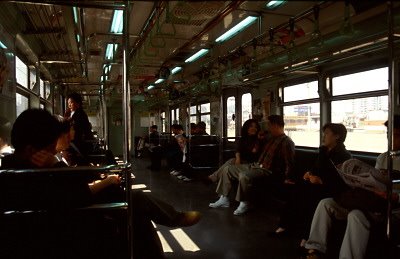subway (underground) anthropology in Taiwan
Savage Minds has a guest post by Anru Lee, Doing Research on Subways in Taiwan, which introduces her current research project. It should be of interest to anyone interested in the workings of Seoul as a metropolis, its dynamics, social and spatial structure and what all that has to do with the Seoul subway/underground/metro. My current research focuses on the subway systems in the two largest cities in Taiwan: Taipei, the capital and economic-cultural center of Taiwan, whose first subway line was completed in 1996; and Kaohsiung, the country’s hub of heavy industries and one of the world’s largest container ports, whose subway system is now under construction. I use the subway systems as a focal point to understand the regional, national, and global processes that are unfolding in Taiwan. Given that many Asian countries are investing heavily on infrastructure including highways and subways (to boost the country’s global economic competitiveness), my research is not just about Taiwan but carries comparative angles.  An orderly picture of an orderly subway line in Seoul. (c) AL 2000 In case I had time and money and sufficient research interest, I'd perhaps investigate something on how the subway system contributes to the social stratification in Seoul. Despite of this Hankyoreh21 column several years back in which the writer says that the subway is characteristically a seomin (lower middle class "ordinary people") way of transportation, the Seoul subway seems to me markedly less stratified than for example its Helsinki counterpart (the single line of it). The Seoul subway net connects such a wide area that one area or one connection cannot give it any flavor; rather, a good access to subway in my understanding is likely to enhance the value of real estate. Not so in Helsinki; the system is imagined more as a line between the not-so-well-off eastern Helsinki and the city center even though there are wealthy neighborhoods with stops along the line. So when the eventual extension of the Helsinki metro westwards to the bourgeois Espoo is discussed, it is expected that there are opponents to the extension who in private think that it would give a too easy access to the clean and orderly Espoo for the unwanted elements of the east. (I've yet to see anyone argue so in public.) (Buses, now the mainstay of public traffic for the most of Espoo, are unlike subway controlled in the sense that the driver checks the tickets.) Such senses - that "uncontrolled" public traffic has social consequences - are not helped by the findings of a research published just today, that the sense of insecurity has increased in the Helsinki region public traffic. Not that the Seoul subway is devoid of signs of destituteness or failings in human life in any way; actually Helsinki lacks the beggars and salespersons (kiabai, see my earlier entry) who so commonly have the Seoul subway as the venue of operation, but their imprint on the overall imagery of the subway is not that conclusive. Categories at del.icio.us/hunjang: anthropology ∙ academic ∙ stratification ∙ urbanspace |



Comments to note "subway (underground) anthropology in Taiwan" (Comments to posts older than 14 days are moderated)
It's quite fun to look at the map at the bottom of this page of the Line 7 extension going through Bucheon (where I used to live). You can see two new developments just to the north of the line (인천삼산1지구 and 여월댁지지구). As there is barely any settlement in the area of the latter development, it would seem pointless to have the subway line pass by there, though it is helpful in making previously uninteresting farmland into a more profitable development.
The same goes for the new Line 9 (map here; pictures of its construction here) which passes through former green belt Magok-dong, which is slated to be turned into an 'international business town' by 2031). The extensive construction in the nearby Kayang-dong and Deungchon-dong areas (which the line will run through) is most certainly motivated by its presence. A friend of mine owns an apartment in Deungchon-dong near a future subway station and is looking forward to selling it when Line 9 opens. I'm sure there are many development projects like this along this line; these are the ones I'm familiar with as they're close to where I live.
Of course, while a lot of property is about to become much more valuable it's always going to be the developers or owners of nearby existing apartments that do well. Anyone owning nearby 'villas' is more likely to see their dwellings torn down to make way for new apartment blocks, which is already happening in my area with increasing frequency.
Write a Comment